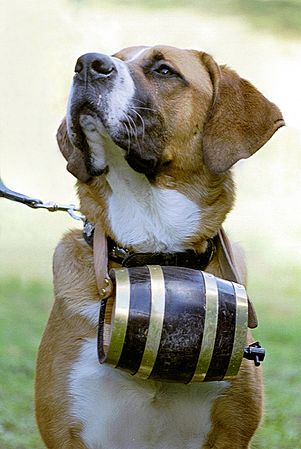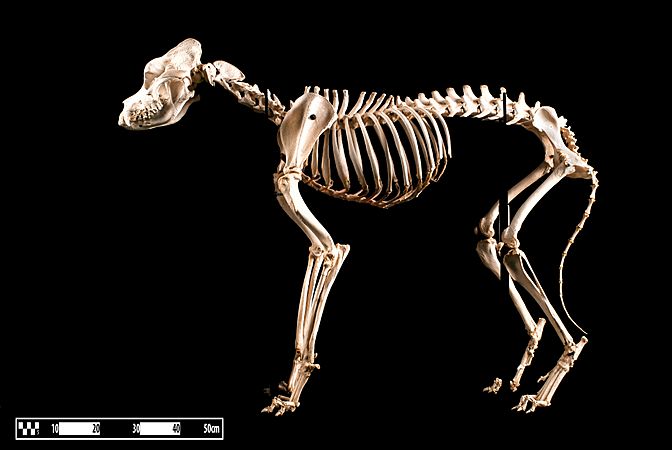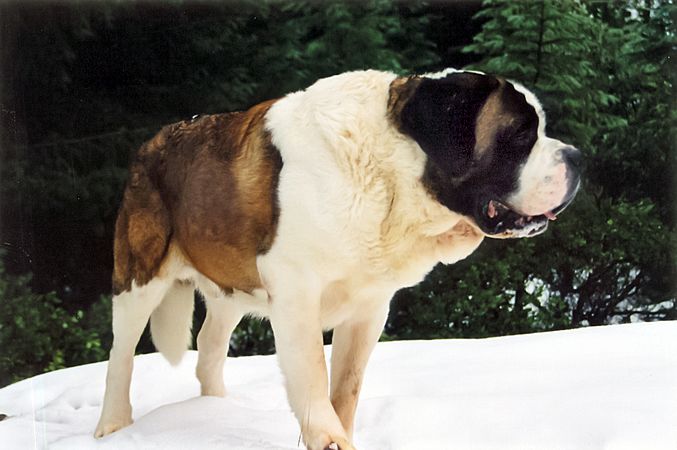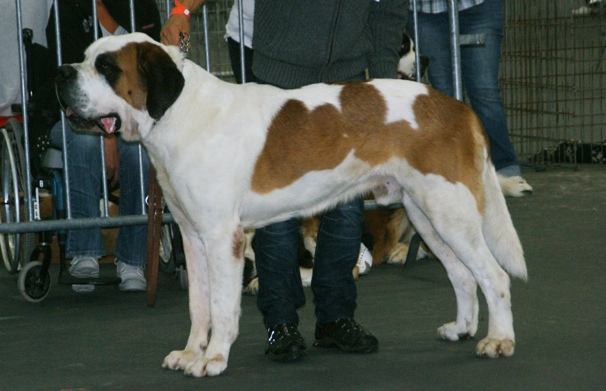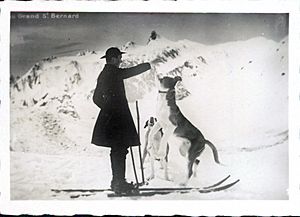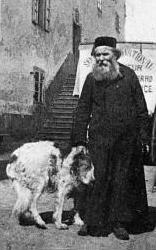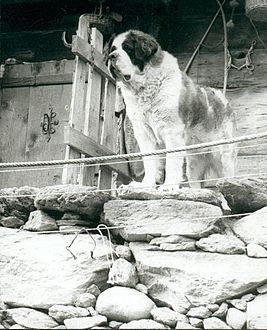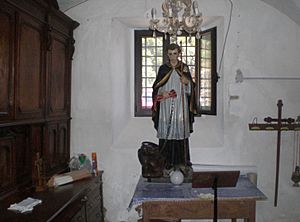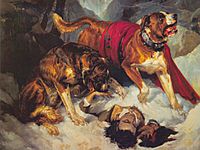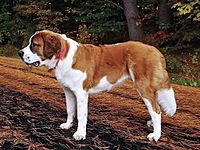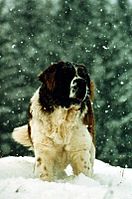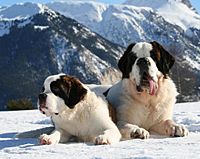St. Bernard (dog) facts for kids
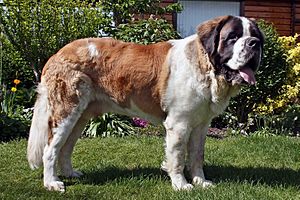
St. Bernard, male, longhaired, 14 months old
|
||||||||||||||||||||||||||
| Other names | St. Bernhardshund Bernhardiner Alpine Mastiff (archaic) |
|||||||||||||||||||||||||
|---|---|---|---|---|---|---|---|---|---|---|---|---|---|---|---|---|---|---|---|---|---|---|---|---|---|---|
| Common nicknames | Saint | |||||||||||||||||||||||||
| Origin | ||||||||||||||||||||||||||
|
||||||||||||||||||||||||||
|
||||||||||||||||||||||||||
| Domestic dog (Canis lupus familiaris) | ||||||||||||||||||||||||||
The St. Bernard is a very large dog breed. It was first bred to help rescue people lost in the snowy Swiss Alps. You might have heard that they carried small barrels of brandy around their necks to warm up cold mountaineers. However, there's no real proof this ever happened! The monks at the St. Bernard Hospice sometimes use these barrels for fun photos with tourists.
St. Bernards are huge dogs with big heads. A fully grown male can weigh between 140 and 180 pounds (63 to 82 kg). The heaviest St. Bernard ever recorded was named Benedictine, weighing 357 pounds (162 kg)!
Contents
Appearance
The St. Bernard is a giant dog. They usually weigh between 65 and 120 kg (140 and 260 lb) or more. They stand about 70 to 90 cm (28 to 35 in) tall at the withers (the highest part of their back, at the base of the neck).
Their coat can be either smooth or rough. The smooth coat is short and lies flat. The rough coat is thick, flat, and longer around their neck and legs. St. Bernards are typically red and white, or mahogany brown with white. They often have black shading on their face and ears.
Their tail is long and heavy, usually hanging low. Their eyes are usually brown, but can sometimes be an icy blue. Their eyelids should fit tightly, with only a small part of the inner eyelid visible.
-
A St. Bernard with the famous barrel. This idea might come from an 1820 painting by Edwin Landseer.
History
The St. Bernard's ancestors are related to other large mountain dogs called Sennenhunds. These dogs were used by farmers in the Alps for many jobs. They guarded livestock, herded animals, pulled carts, and even helped with hunting. They were also good search and rescue dogs and watchdogs. These early dogs are thought to be descendants of large dogs brought to the Alps by the ancient Romans. Today, the St. Bernard is known worldwide as a Molossoid breed, which means it belongs to a group of large, strongly built dogs.
The first written records of the St. Bernard breed come from monks at the Great St Bernard Hospice in 1707. Paintings of these dogs exist even earlier, from 1690. The most famous St. Bernard was a dog named Barry. He reportedly saved between 40 and 100 lives! There's a monument to Barry, and his body is kept at the Natural History Museum in Berne.
The classic St. Bernard looked different from today's dogs. Between 1816 and 1818, harsh winters caused many avalanches. This killed many of the dogs used for breeding. To save the breed, the remaining St. Bernards were crossed with Newfoundlands in the 1850s. This made their fur longer, which was a problem for rescue work. The long fur would freeze and weigh them down in the snow.
The monks didn't specially train the dogs. Instead, younger dogs learned how to find and rescue people by watching older, experienced dogs.
The Swiss St. Bernard Club was started in Basel in 1884. The St. Bernard was the very first breed listed in the Swiss Stud Book that same year. The breed's official standards were approved in 1888. Since then, the St. Bernard has been known as a Swiss national dog.
The working dogs at the St. Bernard hospice were smaller than the show dogs we see today. They were originally about the size of a German Shepherd Dog. Over time, dog shows focused more on how the dogs looked rather than their working skills. This led to the St. Bernard becoming much larger.
-
A St. Bernard rescue dog in Valais.
Naming
The name "St. Bernard" comes from the Great St. Bernard Hospice. This hospice was a place for travelers to rest on the dangerous Great St. Bernard Pass between Switzerland and Italy. The pass, the lodge, and the dogs are all named after Bernard of Menthon. He was an 11th-century Italian monk who started the hospice.
The name "St. Bernard" wasn't widely used until the mid-1800s. Before that, the dogs were called "Saint Dogs," "Noble Steeds," "Alpenmastiff," or "Barry Dogs."
Related breeds
The St. Bernard looks a lot like the English Mastiff. Both breeds share a common ancestor called the Alpine Mastiff. The St. Bernard breed we see today is quite different from the original dogs at the hospice. Modern St. Bernards are much larger.
Since the late 1800s, St. Bernards have been improved by breeding them with many other large Molosser breeds. These include the Newfoundland, Great Pyrenees, Greater Swiss Mountain Dog, Bernese Mountain Dog, Great Dane, and English Mastiff. It's also thought that the Tibetan Mastiff and Caucasian Ovcharka might have been used. Other breeds like the Rottweiler, Boxer, and English Bulldog may also be part of the St. Bernard's family tree. Many of these large breeds were used to help each other survive after World War II. This might explain why they all played a part in creating the St. Bernard we know today.
The four Sennenhund breeds are similar in looks and history. These include the Grosser Schweizer Sennenhund (Greater Swiss Mountain Dog), Berner Sennenhund (Bernese Mountain Dog), Appenzeller Sennenhund (Appenzeller), and Entlebucher Sennenhund (Entlebucher Mountain Dog). They are tricolor (black, white, and brown) instead of red and white.
The Russian army even crossed St. Bernards with Caucasian Ovcharka dogs. This created the Moscow Watchdog, which is still used as a military dog in Russia today. St. Bernards share many traits with livestock guardian dog breeds.
Kennel Club recognition
The St. Bernard is recognized around the world by the Fédération Cynologique Internationale (FCI). They are part of Group 2, Section 2, which includes Molosser dogs. The breed is also recognized by The Kennel Club (UK), the Canadian Kennel Club, and the American Kennel Club in their Working Dog groups. The United Kennel Club in the United States places them in the Guardian Dog Group. The New Zealand Kennel Club and the Australian National Kennel Council list the breed in the Utility Group.
Modern activities
St. Bernard dogs are no longer used for mountain rescues. The last recorded rescue was in 1955. As recently as 2004, the Great St Bernard Hospice still had 18 dogs. They kept them for tradition and because they loved them. That year, the Barry Foundation started breeding kennels for the breed in Martigny, a town near the Great Saint Bernard Pass. They bought the remaining dogs from the Hospice. In the summer, some of these dogs are brought to the Hospice for tourists to see.
Every year, there's a special celebration for the breed at the Little Saint Bernard Pass. It also takes place in the town of Rosières-Montvalzan on the French side. St. Bernard fans and breeders gather for a dog show and parades.
The dogs bred by the Barry Foundation are trained for different dog sports. These include carting (pulling carts) and weight pulling. The dogs at the Barry Foundation are said to be smaller than the average St. Bernard.
Temperament
St. Bernards are known as "gentle giants." They are calm, patient, and sweet with adults, and especially good with children. However, like all very large dogs, St. Bernards need to meet many different people and other dogs when they are young. This helps them grow up to be friendly and not fearful. The biggest risk for small children is that the dog might accidentally knock them over because of its large size. Overall, they are gentle, loyal, and loving dogs. If they are socialized well, they are very friendly.
Because they grow so big, it's important to start training and socializing a St. Bernard when it's still a puppy. This helps avoid problems that can come with training large dogs. A St. Bernard that isn't well-trained can be hard to control, even for a strong adult. So, it's important to be in charge from the start of their training. While they usually aren't protective by nature, a St. Bernard might bark at strangers. Their large size also makes them good at deterring possible intruders.
The St. Bernard was bred to be a working companion. Even today, they love to please their owners and are friendly, hard-working dogs. St. Bernards are naturally good at scent work. Depending on the trainer's skill and the dog's talents, St. Bernards can take part in tracking events or even help with search and rescue work.
Notability
Record size
St. Bernards were brought to England in the mid-1800s. There, they were bred with mastiffs to make them even bigger. Plinlimmon, a famous St. Bernard from that time, weighed 95 kg (210 lbs) and was 87.5 cm (34.5 inches) tall. He was sold to an American for $7000. People wanted bigger and bigger dogs for shows. This led to dogs that were so huge they had trouble walking across a show ring.
A 1895 New York Times report mentioned a St. Bernard named Major F. He was said to be 8 feet 6 inches (2.59 m) long. If this is true, he would be the longest dog in history. Another St. Bernard named Benedictine V Schwarzwald Hof weighed 315 lb (143 kg). This earned him a spot in the 1981 edition of the Guinness Book of World Records.
In media
St. Bernards are often shown in movies and cartoons wearing small barrels of brandy around their necks. The idea was that avalanche victims would drink the brandy to stay warm while waiting for help. However, doctors say this isn't good for someone who is very cold. The monks at the St. Bernard Hospice say their dogs never carried barrels. They think this image comes from an 1820 painting by Edwin Landseer. The monks did keep barrels for tourists to use in photos.
Famous St. Bernards
- Bamse, a Norwegian dog honored for his bravery during World War II. He has a memorial statue in Montrose, Scotland.
- Barry, a very famous Alpine rescue dog.
- Bernie, the mascot of the Colorado Avalanche hockey team.
- Bernie "Saint" Bernard, the mascot for the saints in Dubuque.
- Bernie, the mascot of the Northampton Saints rugby team.
- Gumbo, the team mascot for the New Orleans Saints football team.
- Porthos, J.M. Barrie's dog (the author of Peter Pan).
- Schnorbitz, the on-stage partner of British comedian Bernie Winters.
- Wallace (currently Wallace VI), the mascot of The Canadian Scottish Regiment (Princess Mary's).
Fictional dogs
- Båtsman, a St. Bernard in Astrid Lindgren's story Vi på Saltkråkan.
- Beethoven, from the popular movie series of the same name. The 1992 film Beethoven features a friendly but mischievous 200-pound St. Bernard. In later movies, he has a mate and many playful puppies.
- Bolivar, Donald Duck's pet, and Bolivar's son, Behemoth.
- Buck, from Jack London's 1903 novel, The Call of the Wild. He is described as half St. Bernard and half "Scotch shepherd dog."
- Cujo, a dog who gets rabies and becomes dangerous in the 1981 Stephen King novel Cujo and the 1983 film.
- George, the main dog in the movie "George!" (1971) and its TV show (1972–73).
- Josef, from the Japanese anime series Heidi, Girl of the Alps.
- Nana, in the Disney and Columbia Pictures Peter Pan movies (though she was a Newfoundland in the original play and novel).
- Neil, the martini-drinking St. Bernard in the 1950s TV series Topper.
- Sumo, a St. Bernard belonging to Lt. Hank Anderson in the video game Detroit: Become Human.
See also
 In Spanish: San bernardo (perro) para niños
In Spanish: San bernardo (perro) para niños



